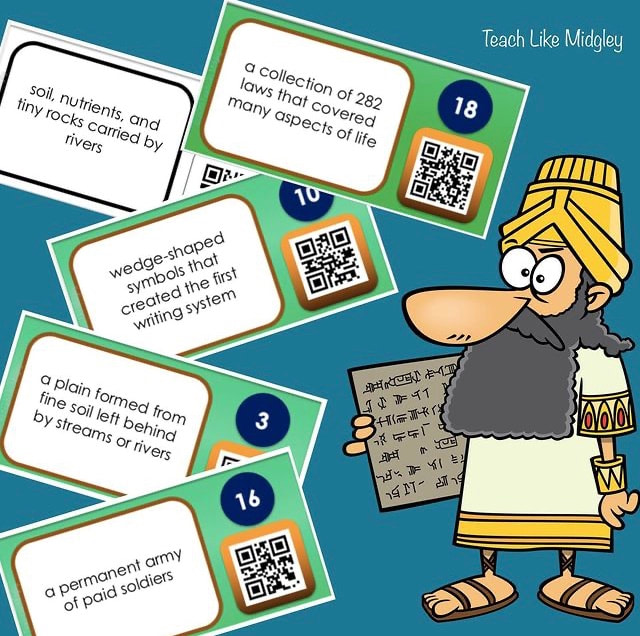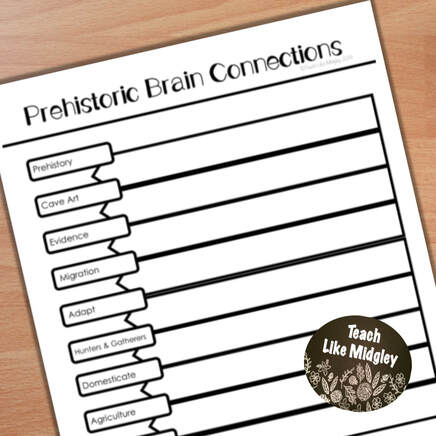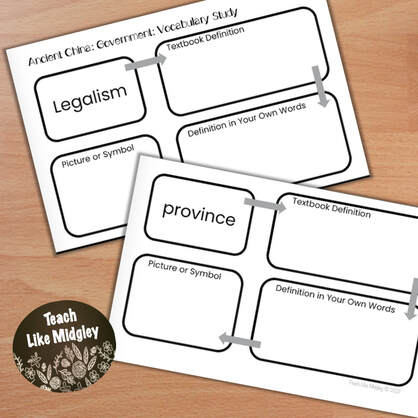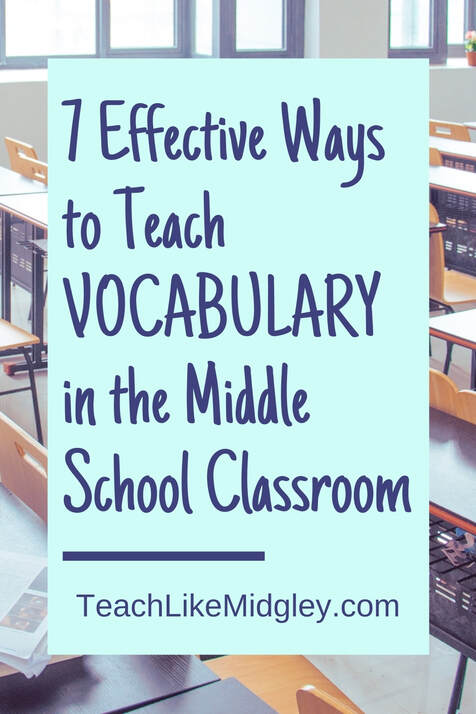7 Effective Ways to Teach Vocabulary
in the Middle School Classroom
Should you have students do vocabulary work in your middle school classroom?
The answer from me is always a resounding YES!
I have no doubts that part of what helps my students learn is a healthy focus on vocabulary words and skills. Practicing vocabulary daily and introducing new vocabulary before a complex lesson have been very successful strategies in my 6th grade classroom.
The answer from me is always a resounding YES!
I have no doubts that part of what helps my students learn is a healthy focus on vocabulary words and skills. Practicing vocabulary daily and introducing new vocabulary before a complex lesson have been very successful strategies in my 6th grade classroom.
In this post you’ll learn 7 strategies for incorporating vocabulary work into your daily lessons.
Word Wall
At first thought, a word wall can often appear to be most effective in the elementary setting, and maybe considered too childish for secondary. However, I have seen some amazing word walls in middle school.
This strategy can be especially effective when words are grouped by unit or theme. Include the word, an image, and a description for each vocabulary word or term.
This strategy can be especially effective when words are grouped by unit or theme. Include the word, an image, and a description for each vocabulary word or term.
Dictionary/Glossary
Should we still be teaching students to use dictionaries and glossaries? ABSOLUTELY. It blows my mind every fall, when I have 6th graders who struggle to look up a word in their glossary. Even though it happens every year, I can still hardly believe it. By the time our school year is over, those kiddos can use that glossary like pros in a fraction of the time.
I can understand not wanting students to simply copy a definition. Obviously there is more to the skill, which is what we need to be teaching our students. How to look up the word, find the definition, and use critical thinking skills to understand it’s meaning. I have found that having students write the glossary definition, and then translate it into their own words to be very effective.
I can understand not wanting students to simply copy a definition. Obviously there is more to the skill, which is what we need to be teaching our students. How to look up the word, find the definition, and use critical thinking skills to understand it’s meaning. I have found that having students write the glossary definition, and then translate it into their own words to be very effective.
Flash Card with Technology
Sometimes it’s fun to give your old fashion vocabulary practice a little boost. Technology is always an easy way to do this.
Anytime you use flash cards, train your students how to sort them into piles so they can practice with them effectively. Use this method:
Shuffle the cards before beginning, so students focus on the material and not the order of appearance.
While flipping through the flash cards place them into 3 piles:
1) Correct
2) Sort of
3) Nope not yet
When finished, go through the “nope not yet” pile until they are all “correct” then do the same for the “sort of” pile. This will help students focus on the information they don’t know as well.
To add some technology fun, instead of putting the vocabulary “answer” on the back of the card, use a QR code.
The card will have the vocabulary definition with a code. When students scan the code, the correct vocabulary word pops up and they can check their answers.
You can easily make QR codes for free online, and there are plenty of free QR code reading apps. The best part, is any device with a camera will work, and it doesn’t have to be connected to the internet.
Anytime you use flash cards, train your students how to sort them into piles so they can practice with them effectively. Use this method:
Shuffle the cards before beginning, so students focus on the material and not the order of appearance.
While flipping through the flash cards place them into 3 piles:
1) Correct
2) Sort of
3) Nope not yet
When finished, go through the “nope not yet” pile until they are all “correct” then do the same for the “sort of” pile. This will help students focus on the information they don’t know as well.
To add some technology fun, instead of putting the vocabulary “answer” on the back of the card, use a QR code.
The card will have the vocabulary definition with a code. When students scan the code, the correct vocabulary word pops up and they can check their answers.
You can easily make QR codes for free online, and there are plenty of free QR code reading apps. The best part, is any device with a camera will work, and it doesn’t have to be connected to the internet.
Required Use in Writing Repeatedly
The more students use their vocabulary words, the more they will come to know and understand them. Use them often and ask students about them often.
Reviewing and refreshing your memory about vocabulary words are always helpful when warming up for new lessons and reviewing old lessons. I always encourage students to use their vocabulary words when they are answering questions and especially when writing summaries.
Reviewing and refreshing your memory about vocabulary words are always helpful when warming up for new lessons and reviewing old lessons. I always encourage students to use their vocabulary words when they are answering questions and especially when writing summaries.
Brain Chains
This is a fun exercise to get your students to think critically about vocabulary terms and how they are connected to each other.
Simply give students two vocabulary words and ask them to write 1-2 sentences that include both words and show their connection.
For example, if you had to link students and mentors you might write:
“Although sixth grade students are working hard to prepare for middle school, they can also make excellent mentors for younger children who are just learning how to read.”
You can make it more challenging by giving students a list of vocabulary words and having them write a sentence that connects two at a time, in order.
Simply give students two vocabulary words and ask them to write 1-2 sentences that include both words and show their connection.
For example, if you had to link students and mentors you might write:
“Although sixth grade students are working hard to prepare for middle school, they can also make excellent mentors for younger children who are just learning how to read.”
You can make it more challenging by giving students a list of vocabulary words and having them write a sentence that connects two at a time, in order.
Map It Out
This is a great exercise to include with your glossary or dictionary practice. Have students write the definition from the glossary, then write it’s meaning in their own words, and then include a small picture or symbol that can also represent the meaning.
Teach Students How to Identify Vocabulary
Every subject area has vocabulary words. Whether you straight up call it vocabulary or not. The best skill you can teach your students is how to identify the vocabulary terms for a unit of study independently. This way, if they encounter a teacher who does not provide them with a vocabulary list, they are able to create their own.
Teach students how to determine vocabulary words from textbooks and from supplementary readings and articles.
Teach students how to determine vocabulary words from textbooks and from supplementary readings and articles.
Ready to Roll Materials...
Now that you have a few fun ways to include vocabulary into your instruction, you are ready to roll.
There really aren’t a lot of materials needed to do vocabulary work. Have students grab their textbook, notebook and paper, and you’ve got an activity.
But if you are looking for a little bit more, then you may want to check out my QR code vocabulary cards for ancient history. Also note that my ancient history lesson sets all include vocabulary study materials that incorporate the map-it-out strategy.
You may also be interested in my subject specific study strategy cards that are perfect for teaching your students effective study methods.
Choose whichever methods will work best for your students. Just don’t leave out vocabulary work! It can be such a powerful tool in helping students learn.
There really aren’t a lot of materials needed to do vocabulary work. Have students grab their textbook, notebook and paper, and you’ve got an activity.
But if you are looking for a little bit more, then you may want to check out my QR code vocabulary cards for ancient history. Also note that my ancient history lesson sets all include vocabulary study materials that incorporate the map-it-out strategy.
You may also be interested in my subject specific study strategy cards that are perfect for teaching your students effective study methods.
Choose whichever methods will work best for your students. Just don’t leave out vocabulary work! It can be such a powerful tool in helping students learn.
You May Also Like...
Let's Connect...

Welcome! I'm Hillary Midgley, a veteran 6th grade teacher.
I create educational materials and develop curriculum for other teachers. I specialize in teaching students how to learn through my Study Skills Curriculum. I have established fundamental classroom systems and structures for teachers to help them streamline their classroom. And my passion is teaching ancient history through engaging activities with foundations in academic skills. Here you will find resources on all of these topics and more. Learn more about me here.
|











